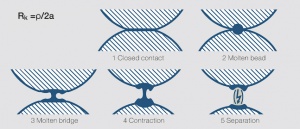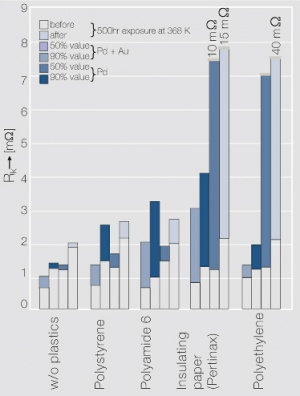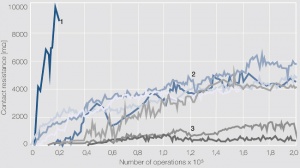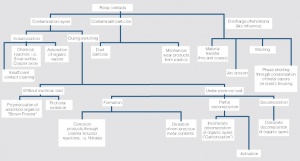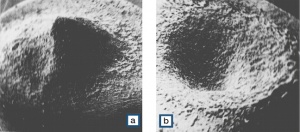Difference between revisions of "Switching Contacts"
(→6.4.4 Switching Contacts) |
|||
| Line 1: | Line 1: | ||
| − | ===6.4.4 Switching Contacts=== | + | ===<!--6.4.4-->Switching Contacts=== |
<ul> | <ul> | ||
<li>'''Effects during switching operations'''</li> | <li>'''Effects during switching operations'''</li> | ||
| − | <xr id="fig:Contact_opening_with_arc_formation_schematic"/> Fig. 6.7: Contact opening with arc formation schematic | + | <xr id="fig:Contact_opening_with_arc_formation_schematic"/><!--Fig. 6.7:--> Contact opening with arc formation schematic |
<div class="multiple-images"> | <div class="multiple-images"> | ||
| Line 14: | Line 14: | ||
<li>'''Influence of out-gasing from plastics'''</li> | <li>'''Influence of out-gasing from plastics'''</li> | ||
| − | <xr id="fig:Histogram_of_the_contact_resistance_Rk"/> Fig. 6.9: Histogram of the contact resistance Rk of an electroplated palladium layer (3 μm) with and without hard gold flash plating (0.2 μm) after exposure with different plastic materials | + | <xr id="fig:Histogram_of_the_contact_resistance_Rk"/><!--Fig. 6.9:--> Histogram of the contact resistance Rk of an electroplated palladium layer (3 μm) with and without hard gold flash plating (0.2 μm) after exposure with different plastic materials |
| − | <xr id="fig:Contact resistance with exposure to out gasing from plastics"/> Fig. 6.10: Contact resistance with exposure to out gasing from plastics as a function of numbers of operations at 6 V<sub>DC</sub>,100 mA: 1 Silicon containing plastic; 2 Plastics with strongly out-gasing components; 3 Plastics with minimal out-gasing components | + | <xr id="fig:Contact resistance with exposure to out gasing from plastics"/><!--Fig. 6.10:--> Contact resistance with exposure to out gasing from plastics as a function of numbers of operations at 6 V<sub>DC</sub>,100 mA: 1 Silicon containing plastic; 2 Plastics with strongly out-gasing components; 3 Plastics with minimal out-gasing components |
| Line 33: | Line 33: | ||
<li>'''Influence of corrosive gases on the contact resistance'''</li> | <li>'''Influence of corrosive gases on the contact resistance'''</li> | ||
| − | <xr id="fig:Distribution of cumulative frequency H of the contact resistance for solid contact rivets"/> Fig. 6.11: Distribution of cumulative frequency H of the contact resistance for solid contact rivets after 10 days exposure in a three-component test environment with 400 ppb each of H<sub>2</sub>S, SO<sub>2</sub> and NO<sub>2</sub> at 25°C, 75% RH; Contact force 10cN; Measuring parameters: ≤ 40 mV<sub>DC</sub>,10 mA; Probing | + | <xr id="fig:Distribution of cumulative frequency H of the contact resistance for solid contact rivets"/><!--Fig. 6.11:--> Distribution of cumulative frequency H of the contact resistance for solid contact rivets after 10 days exposure in a three-component test environment with 400 ppb each of H<sub>2</sub>S, SO<sub>2</sub> and NO<sub>2</sub> at 25°C, 75% RH; Contact force 10cN; Measuring parameters: ≤ 40 mV<sub>DC</sub>,10 mA; Probing |
contact: Gold rivet | contact: Gold rivet | ||
| Line 52: | Line 52: | ||
<li>'''Material transfer'''</li> | <li>'''Material transfer'''</li> | ||
| − | <xr id="fig:Material transfer under DC load"/> Fig. 6.12: Material transfer under DC load a) Cathode; b) Anode. <br /> Material: AgNi0.15; Switching parameters: 12V<sub>DC</sub>, 3 A, 2x10<sup>6</sup> operations | + | <xr id="fig:Material transfer under DC load"/><!--Fig. 6.12:--> Material transfer under DC load a) Cathode; b) Anode. <br /> Material: AgNi0.15; Switching parameters: 12V<sub>DC</sub>, 3 A, 2x10<sup>6</sup> operations |
<div class="multiple-images"><figure id="fig:Material transfer under DC load">[[File:Material transfer under DC load.jpg|left|thumb|<caption>Material transfer under DC load a) Cathode; b) Anode. <br /> Material: AgNi0.15; Switching parameters: 12V<sub>DC</sub>, 3 A, 2x10<sup>6</sup> perations</caption>]]</figure></div> | <div class="multiple-images"><figure id="fig:Material transfer under DC load">[[File:Material transfer under DC load.jpg|left|thumb|<caption>Material transfer under DC load a) Cathode; b) Anode. <br /> Material: AgNi0.15; Switching parameters: 12V<sub>DC</sub>, 3 A, 2x10<sup>6</sup> perations</caption>]]</figure></div> | ||
| Line 59: | Line 59: | ||
<li>'''Arc erosion'''</li> | <li>'''Arc erosion'''</li> | ||
| − | <xr id="fig:Arc erosion of a AgSnO2 contact pair after extreme arcing conditions"/> Fig. 6.13: Arc erosion of a Ag/SnO<sub>2</sub> contact pair after extreme arcing conditions a) Overall view; b) Partial detail view | + | <xr id="fig:Arc erosion of a AgSnO2 contact pair after extreme arcing conditions"/><!--Fig. 6.13:--> Arc erosion of a Ag/SnO<sub>2</sub> contact pair after extreme arcing conditions a) Overall view; b) Partial detail view |
<div class="multiple-images"><figure id="fig:Arc erosion of a AgSnO2 contact pair after extreme arcing conditions">[[File:Arc erosion of a AgSnO2 contact pair after extreme arcing conditions.jpg|left|thumb|<caption>Arc erosion of a Ag/SnO<sub>2</sub> contact pair after extreme arcing conditions a) Overall view; b) Partial detail view</caption>]]</figure></div> | <div class="multiple-images"><figure id="fig:Arc erosion of a AgSnO2 contact pair after extreme arcing conditions">[[File:Arc erosion of a AgSnO2 contact pair after extreme arcing conditions.jpg|left|thumb|<caption>Arc erosion of a Ag/SnO<sub>2</sub> contact pair after extreme arcing conditions a) Overall view; b) Partial detail view</caption>]]</figure></div> | ||
| Line 66: | Line 66: | ||
<li>'''Contact welding'''</li> | <li>'''Contact welding'''</li> | ||
| − | <xr id="fig:Micro structure of a welded contact pair after extremely high current load"/> Fig. 6.14: Micro structure of a welded contact pair (Ag/SnO<sub>2</sub>88/12 - Ag/CdO88/12) after extremely high current load. a) Ag/SnO<sub>2</sub>88/12; b) Ag/CdO88/12 | + | <xr id="fig:Micro structure of a welded contact pair after extremely high current load"/><!--Fig. 6.14:--> Micro structure of a welded contact pair (Ag/SnO<sub>2</sub>88/12 - Ag/CdO88/12) after extremely high current load. a) Ag/SnO<sub>2</sub>88/12; b) Ag/CdO88/12 |
<div class="multiple-images"> | <div class="multiple-images"> | ||
Revision as of 13:03, 19 May 2014
Switching Contacts
- Effects during switching operations
- Influence of out-gasing from plastics
- Influence of corrosive gases on the contact resistance
- Contact Phenomena under the influence of arcing Matertia
- Material transfer
- Arc erosion
- Contact welding
Figure 1 Contact opening with arc formation schematic
Figure 2 Histogram of the contact resistance Rk of an electroplated palladium layer (3 μm) with and without hard gold flash plating (0.2 μm) after exposure with different plastic materials
Figure 3 Contact resistance with exposure to out gasing from plastics as a function of numbers of operations at 6 VDC,100 mA: 1 Silicon containing plastic; 2 Plastics with strongly out-gasing components; 3 Plastics with minimal out-gasing components
Figure 4 Distribution of cumulative frequency H of the contact resistance for solid contact rivets after 10 days exposure in a three-component test environment with 400 ppb each of H2S, SO2 and NO2 at 25°C, 75% RH; Contact force 10cN; Measuring parameters: ≤ 40 mVDC,10 mA; Probing contact: Gold rivet
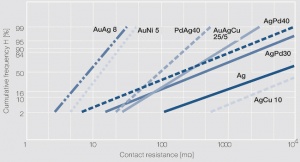
Fig. 6.8: Influences on contact areas in relays
Figure 5 Material transfer under DC load a) Cathode; b) Anode.
Material: AgNi0.15; Switching parameters: 12VDC, 3 A, 2x106 operations
Figure 6 Arc erosion of a Ag/SnO2 contact pair after extreme arcing conditions a) Overall view; b) Partial detail view
Figure 7 Micro structure of a welded contact pair (Ag/SnO288/12 - Ag/CdO88/12) after extremely high current load. a) Ag/SnO288/12; b) Ag/CdO88/12
